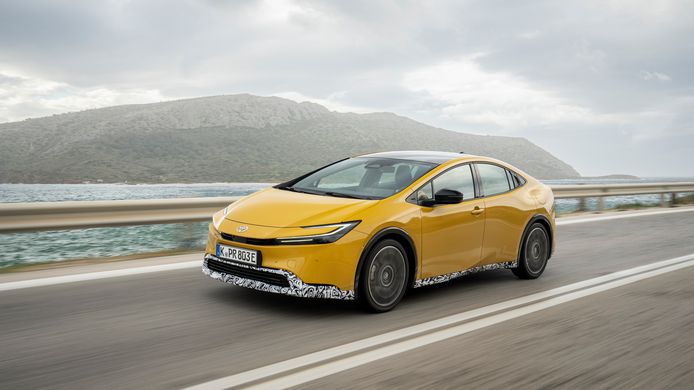Self testIt took five generations for the Toyota Prius to evolve from an ugly duckling to a beautiful swan. The new model will go on sale soon, and the time has come. Because it seems Toyota’s gold pan has lost a lot of its sheen in recent years.
With more than 22 million units sold since 1997, the Prius has been the backbone of Toyota’s hybrid offering for nearly 30 years. The model has become one of the mainstays of Toyota and one of the most successful vehicles of all time for the Japanese brand.
At the time, it was a brave decision by a naturally risk-averse brand to release this model, because the competition saw nothing in the hybrid. Coupling two different engines would make cars unnecessarily complex, unreliable and expensive, and the extra weight of the batteries and extra motor would undoubtedly negate any fuel savings.
But Toyota persevered and the Prius became a leader in hybrid technology. He was also born under a favorable star. Because despite looking like a wet rag, the Prius quickly became the darling of movie stars and climate activists. The small anti-hero was embraced by movie stars like Leonardo DiCaprio and Cameron Diaz because of the car’s eco-friendly image. And in the years since, he has also faced the tide. Taxi drivers around the world have embraced the Prius for its low fuel consumption and good build quality. Toyota built the car very aggressively, fearing that no one would buy the car with its complex technology.
There’s a lot of competition for the Prius – also within the company
Later, tax incentives were added in quite a few places in the world, so that you can sometimes buy or lease a Prius for an apple and an egg. In short, it looked as if the car was just lucky hanging on its ass. But with the latest generation, introduced in 2016, the success story seemed to come to an end. Green drivers have now switched to all-electric vehicles, subsidies have been cut, and the Prius was facing plenty of competition—not least at home, from more practical hybrid models like the Corolla and RAV4.
So Toyota engineers desperately wondered how to proceed. “We questioned whether we should make the Prius an all-electric car,” says project leader Oya Satoki. “But we wanted to make it affordable for everyone and that’s why we decided to make the car as economical as possible.”
Nice wedge shape
Something worked out, given the official consumption of 0.8 liters per 100 km. But it seems that the guys remembered something else, because this time they managed to turn the Prius into a beautiful car. So gone are the ridiculously small wheels, the car gets a nice wedge shape with thick sides and they’ve pretty much modernized the interior.
It would be an exaggeration to say that innovations make the car desirable, but it cannot be denied that it has now certainly lost the image of goat wool socks. Everything about the new model is actually better, except for headroom. Due to the value of Cd (minimum air resistance), the roof was lowered, so that people over 1.90 meters tall – both front and back – would at once rub their crown against the roof. The new steering column also feels a bit large and moves closer to you, making the interior less spacious than its predecessor. However, the new model is a relief compared to its predecessor, which was already equipped with an outdated interior in 2016.
Leadership is also more than just a leap forward. Where the fourth generation had a loud, boomy chassis, felt ponderous and had fuzzy steering, the new model drives refined and agile. Especially in corners, handling is greatly improved. Despite the sport mode, this Toyota never became difficult, but a fun driving car. There’s also nothing to complain about in terms of power, because with 223 horsepower and a 0-100 sprint in 6.7 seconds, this hybrid is just as fast as a Porsche 911 from the ’80s.
The CVT box remained
What’s left, which Toyota didn’t want to fork out for the sake of fuel economy, is the CVT gearbox. The Continuously Variable Transmission ensures that the engine runs at a constant speed for as long as possible, reducing fuel consumption. The downside is that – especially when you hit the throttle deeper – you’ll encounter a high-revving engine noise that may sound annoying to some. If you want to look on the bright side, you could say that this helps you forget about racing, which in turn has a positive effect on your fuel consumption. In addition, if you are driving normally, the monotonous hum is barely audible.
In Europe, the 1,600 kilogram model is now only available as a plug-in variant. A logical choice given the large number of charging stations, especially in the Netherlands. Plus, consumers can already get plug-in hybrid drive technology in models like the Corolla Cross or CH-R. Toyota reports that the Prius plug-in can travel 69 kilometers on a full battery without having to start the petrol engine. This is 50 percent more than its predecessor. This means that the average commuter in the Netherlands can easily travel to and from his place of work. Moreover, it is still possible to choose a roof equipped with solar panels, which, according to Toyota, can generate up to 8.7 kilometers of electricity per day.
The new Toyota Prius will be available from summer, with prices starting around 50,000 euros.
Unlimited free access to Showbytes? Which can!
Log in or create an account and never miss a thing from the stars.

“Lifelong zombie fanatic. Hardcore web practitioner. Thinker. Music expert. Unapologetic pop culture scholar.”












